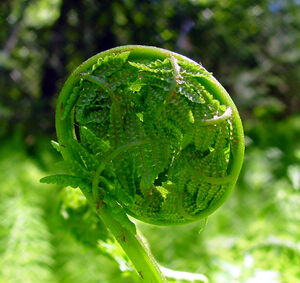
Fiddlehead Fern
Name Variations[]
- fern brake
- pohole
- fiddlehead greens
- fern
- bracken
About Fiddlehead[]
Wikipedia Article About Fiddlehead on Wikipedia
A young, edible, tightly coiled fern frond that resembles the spiral end of a violin (fiddle). It is also referred to as ostrich fern and pohole. The shoots are in their coiled form for only about 2 weeks before they unfurl into graceful greenery. Fiddlehead ferns are a rich, deep green color and are about 2 inches long and l 1/2 inches in diameter. They have a flavor akin to an asparagus-green bean-okra cross and a texture that's appealingly chewy. Fiddleheads should be washed and the ends trimmed before being briefly cooked by steaming, simmering or sautéing. They may be served cooked as a first course or side dish or used raw in salads. Fiddlehead ferns are a good source of vitamins A and C.
Fiddlehead is a name referring either to a young fern or to the top part of immature fronds that appear curled. The fiddlehead, or circinate vernation, unrolls as the fern matures and grows due to more growth in the inside of the curl.
The fiddlehead resembles the curled ornamentation (called a scroll) on the end of a stringed instrument, such as a fiddle. It is also called a crozier, after the curved staff used by shepherds and bishops.
The fiddleheads of certain ferns are eaten as a cooked leaf vegetable. The most popular of these are:
- Bracken, Pteridium aquilinum, found worldwide
- Ostrich fern, Matteuccia struthiopteris, found in northern regions worldwide, and the central/eastern part of North America
- Cinnamon fern or buckhorn fern, Osmunda cinnamomea, found in the Eastern parts of North America
- Royal fern, Osmunda regalis, found worldwide
- Zenmai or flowering fern, Osmunda japonica, found in East Asia
- Vegetable fern, Athyrium esculentum, found throughout Asia and Oceania
Some ferns contain carcinogens, and Bracken has been implicated in stomach cancer. Despite this, most people can eat ostrich and cinnamon fern fiddleheads without any problems, and ostrich fern fiddleheads are a traditional dish of New Brunswick. In 1994, there were several instances of food poisoning associated with raw or lightly cooked fiddleheads in New York state and Western Canada. No definitive source of the food poisoning was identified, and authorities recommended thorough cooking of fiddlehead ferns to counteract any possible unidentified toxins in the plant.
Many ferns also contain the enzyme thiaminase, which breaks down thiamine. This can lead to beriberi and other vitamin B complex deficencies if consumed to excess or if one's diet is lacking in these vitamins.
Fiddleheads have been part of traditional diets in much of Asia, Australia and New Zealand, as well as among Native Americans for centuries. In Japan, bracken fiddleheads (known locally as わらび or 蕨, warabi) are a prized dish, and roasting the fiddleheads is reputed to neutralize any toxins in the vegetable.
